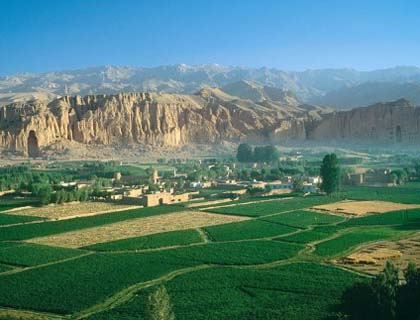A grand ceremony was held on Friday June 05, 2015 in Bamyan province to celebrate the Cultural Capital of South Asian Association for Regional Cooperation (SAARC). Last year on June 21st, Certificate of declaring Bamyan as SAARC cultural capital for the year 2015 was submitted by director of SAARC's cultural center, Mr. Samarasinghe, to Afghanistan's ex-Minister of Information and Culture Dr. Sayed Makhdoom Raheen.
Last year, the SAARC delegation visited various heritage sites in Bamyan and inspected various facilities that already exist and those that are coming up in near future. The delegation that also visited Afghanistan's first National Park, Band-e-Amir, Shahr-e-Zohak and Shahr-e-Gholghola, underlined the tremendous touristic potential that city and its environs has to offer. Bamyan was nominated as SAARC cultural capital on the grounds of cultural backgrounds. In the historical heydays, Bamyan was one of the most holy places for the Buddhists all over the world. Buddha's followers used to visit there every year for ritual purposes. Moreover, Bamyan played the role of the main and nearest link road between the Central Asia and Sub Continent. Therefore, at that time thousands of trade caravans were using Bamyan as junction.
For accommodations of these thousands of people some twelve caves were made in Foladi and Kakrak passes. During the modern era of Afghanistan this historical heritage was badly damaged during the regime of Amir Abdul Rahman (1880-1901) when Amir conquered this region after a long and severe battle (1880-1893). King Amanullah (1919-1929) was the first ruler of Kabul who came to know about the importance of this historical heritage and declared the value of the national heritage of Afghanistan. At first he removed Surrais (hotels) away from the statues, and made vacant the caves by the occupied people and their cattle.
Later on he invited French archaeologists for chronological survey of this historical site. In May 1997, the Taliban commander Mullah Wahid raised statement that after having held Bamyan city the whole heritage would be blown-up. At that time they did several attacks on Bamyan city. Ultimately in March 2001, the twin giant Buddha statues – called "Salsal" measured 53 meters tall and "Shahmama" 35 meters – were destroyed by the Taliban. In the end of February 2001, when Taliban were busy to demolish the Buddha statues, hundreds archaeologists, scholars, priests and politicians around the world urged the Taliban to stop demolishing statues for two main reasons: firstly, the two priceless statues belonged not only to Afghanistan's cultural heritage but also to the world. Secondly, they inspired million Buddhist believers around the world and the destruction would be injurious to their feelings. The Buddhist counties like Sri Lanka, Nepal, Japan, Thailand, India and others reacted so angrily and condemned the Taliban's act of vandalism. Iran also condemned the demolishing of Buddha statues by Taliban in the name of Islam. Iran news wrote, "Islam has never preached the destruction of objects that embody the belief and history of millions of people throughout the world''.
Moreover, Francisco Vendrell flew to Kabul with protest notes from Mr. Annan to meet Malawi Muttawakil the Taliban foreign minister at that time, but he was given short shrift. The abandoned relics are not our pride first of all Muttawakil told Vendrell. "Our soldiers are working very hard to demolish their remaining parts. They will come down soon…" he continued. History gives unbiased testimony that Bamyan Buddhas never harmed or humiliated others' beliefs, including the Taliban's beliefs, or cultures. They always stood innocuous and silently watched the brutalities including Taliban's barbarism in their birth valley. The only sin of Buddha statues was that they were eye-witnesses of Taliban's cruelty and barbarism in Bamyan and beyond it.
Therefore, Taliban after five years of dictatorial regime in Afghanistan decided to get rid of these eye-witnesses in order to conceal their crimes. Bamyan, the heart of Afghanistan, is fraught with poignant stories. This wounded heart is still bleeding for sustaining indescribable pains and anguishes. This is not only the monument of cultural heritages and civilizations but also of violent deaths and gory massacres. This heart keeps unspoken words and tragedies. Since Bamyan was the casualty of historical wars and conflagrations, there yet remain tangible symptoms. As a result, a considerable number of Bamyan residents live in humid caves which lack the most basic facilities such as clean water, electricity, etc.
The central government has turned a blind eye to the public challenges despite their urges. I hope declaring Bamyan as SAARC Cultural Capital will bring the province into international concentration and this will convey a broader positive image from Afghanistan to the world. Moreover, as Bamyan is one of the secure provinces in the country and there are no barriers for political, social and cultural activities, the challenges should have been addressed years ago. Now, the public problems have to be prioritized by the state and international institutions. The residents are to be entitled the rights to enjoy social welfare and economic wellbeing. The state will have to do its best to "attain a prosperous life and sound living environment for all inhabitants of this land; and, eventually, regain Afghanistan's appropriate place in the international family". Prayerfully, the historical wounds of this province will be healed through cultural, social, economic and political activities.

